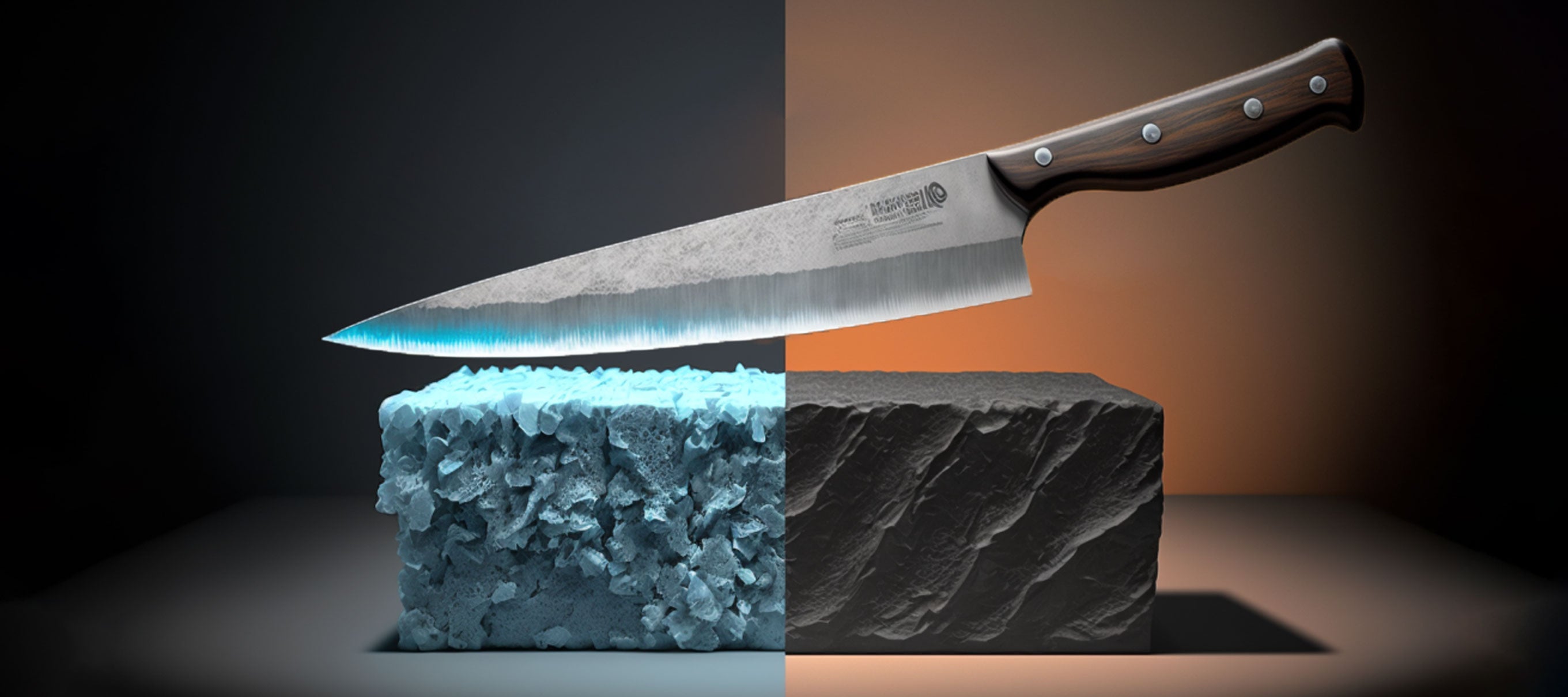
Sharpening stones – the unsung heroes of the tool box. They keep our blades sharp and our tools working like they're supposed to. But with so many types of sharpening stones out there, it can be tough to know which one to choose. Should you go for oil or water? It's like being asked if you prefer dogs or cats. They both have their own unique traits, and it all comes down to personal preference. So buckle up, folks, because we're about to dive into the world of oil and water stones and discover the differences between these two sharpening powerhouses. Let's get ready to rumble – oil versus water, who will come out on top?
Table of contents
Introduction to sharpening stones
Sharpening stones are tools used to sharpen and maintain the edge of knives, blades, and tools. They come in various shapes, sizes, and materials, with the two main types being oil stones and water stones or better know as whetstones.
The choice between oil and whetstones depends on personal preference and the type of tool being sharpened.
Sharpening stones work by removing small amounts of metal from the edge of a blade, creating a new, sharp edge. The process can be done by hand or with the help of a honing guide, and proper technique is essential to achieve a sharp and long-lasting edge.
Overall, sharpening stones are an essential tool for keeping blades sharp and ready for use. Whether you are a professional chef, woodworker, or simply someone who wants to maintain their kitchen knives, a sharpening stone is a useful tool to have in your collection.
Differences between oil and whetstones
-
Material: Oil stones are made from aluminum oxide or silicon carbide and are typically coated with oil or honing oil to reduce friction and prevent the stone from clogging with metal shavings. Whetstones, on the other hand, are made from a combination of abrasive materials such as aluminum oxide, silicon carbide, or Novaculite and are used with water as a lubricant.
-
Grit Range: Oil stones typically have a lower grit range compared to whetstones, with most oil stones having a grit range of 220 to 1000. Whetstones, on the other hand, have a much wider grit range, from around 200 to 8000, allowing for more precise honing and polishing.
-
Speed of Sharpening: Oil stones are generally slower than Whetstones, and because they use oil, they can take longer to sharpen a blade. whetstones are faster and more efficient, but they can also wear out faster.
-
Maintenance: Oil stones require frequent oiling to keep them in good condition, while whetstones need to be soaked in water before use to prevent cracking.
-
Price: Oil stones are typically less expensive compared to whetstones, but they also have a shorter lifespan. whetstones are more expensive, but they last longer and provide a higher quality edge.
| Feature | Oil Stones | Whetstones |
|---|---|---|
| Material | Aluminium oxide or silicon carbide | Aluminium oxide, silicon carbide, or Novaculite |
| Lubricant | Oil | Water |
| Grit Range | 220 to 1000 | 200 to 8000 |
| Speed of Sharpening | Slow | Fast |
| Maintenance | Requires frequent oiling | Needs to be soaked in water before use |
| Price | Less expensive | More expensive |
| Lifespan | Shorter | Longer |
Both oil and whetstones have their own unique advantages and disadvantages, and the choice between the two depends on personal preference and the type of tool being sharpened. Whether you're looking for a stone that's fast and efficient or one that's durable and long-lasting, there's a sharpening stone out there that's right for you.
How to tell if a stone is oil or water based
There are several ways to determine if a sharpening stone is oil or water based:
-
Look at the packaging: The packaging of a sharpening stone often indicates whether it is oil or water based. If the packaging mentions oil or honing oil, it is likely an oil stone, while if it mentions soaking in water, it is likely a water stone.
-
Check the surface: An oil stone will have a porous, almost spongy surface that is coated with oil. A water stone, on the other hand, will have a smoother surface that is free of oil.
-
Test the stone: To determine if a stone is oil or water based, you can place a few drops of water on the stone and observe how it reacts. If the water beads up and does not soak in, it is likely an oil stone. If the water is absorbed into the stone, it is likely a water stone.
-
Ask the manufacturer or seller: If you're not sure if a sharpening stone is oil or water based, you can reach out to the manufacturer or seller for clarification. They should be able to provide you with the information you need.
Advantages and disadvantages of oil and whetstones
Oil Stones: Advantages:
-
Low cost: Oil stones are typically less expensive compared to whetstones, making them a good choice for those on a budget.
-
Low maintenance: Oil stones require little maintenance, just the occasional application of oil to keep the stone lubricated and prevent it from becoming clogged with metal shavings.
-
Versatility: Oil stones have a lower grit range, making them suitable for general purpose sharpening and maintenance of knives, blades, and tools.
Disadvantages:
-
Slow sharpening speed: The use of oil as a lubricant makes oil stones slower than whetstones, which can take longer to sharpen a blade.
-
Short lifespan: The oil used on oil stones can eventually become rancid, affecting the sharpening performance and shortening the lifespan of the stone.
whetstones: Advantages:
-
Fast sharpening speed: The use of water as a lubricant makes whetstones faster than oil stones, enabling them to quickly sharpen blades and tools.
-
Long lifespan: whetstones are durable and long-lasting, making them a good investment for those who sharpen frequently.
-
Wide range of grits: whetstones are available in a wide range of grits, from 200 to 8000, making them suitable for fine honing and polishing, as well as general sharpening.
Disadvantages:
-
High cost: Whetstones are typically more expensive compared to oil stones, making them a less affordable option for those on a budget.
-
Maintenance: whetstones need to be soaked in water before use, and they can become contaminated with metal shavings, which can affect the sharpening performance.
| Category | Oil Stones | Whetstones |
|---|---|---|
| Cost | Lower cost | Higher cost |
| Maintenance | Low maintenance | Higher maintenance |
| Sharpening Speed | Slow | Fast |
| Lifespan | Short lifespan | Long lifespan |
| Grit Range | Lower grit range | Wide range of grits |
Both oil and whetstones have their own unique advantages and disadvantages, and the choice between the two depends on personal preference and the type of tool being sharpened. Whether you're looking for a stone that's fast and efficient or one that's durable and long-lasting, there's a sharpening stone out there that's right for you.
Maintenance and care for oil and whetstones
Oil Stones
Maintenance: Oil stones require little maintenance, just the occasional application of oil to keep the stone lubricated and prevent it from becoming clogged with metal shavings. A light oil, such as mineral oil, is recommended for use with oil stones. It's important to periodically clean the stone of any metal shavings and to apply a light coat of oil to keep the stone lubricated.
Care: To extend the lifespan of an oil stone, it's important to store it properly when not in use. This means keeping it in a dry place and avoiding exposing it to moisture. It's also important to periodically clean the stone of any metal shavings to prevent it from becoming clogged.
Whetstones
Maintenance: Whetstones need to be soaked in water before use, and they can become contaminated with metal shavings, which can affect the sharpening performance. To prevent contamination, it's important to regularly clean the stone with a soft brush and to rinse it thoroughly with water.
Care: To extend the lifespan of a water stone, it's important to store it properly when not in use. This means keeping it in a dry place and avoiding exposing it to moisture. It's also important to avoid dropping the stone, as it can chip or crack. Additionally, it's important to periodically flatten the surface of the stone to maintain its sharpening performance.
| Category | Oil Stones | Whetstones |
|---|---|---|
| Maintenance | Occasional application of oil to keep the stone lubricated and prevent it from becoming clogged with metal shavings. Clean periodically of any metal shavings and apply a light coat of oil to keep lubricated. | Soak in water before use and clean regularly with a soft brush to prevent contamination. Rinse thoroughly with water. |
| Care | Store in a dry place and avoid exposing to moisture. Clean of any metal shavings to prevent it from becoming clogged. | Store in a dry place and avoid exposing to moisture. Avoid dropping to prevent chipping or cracking. Periodically flatten the surface to maintain sharpening performance. |
Both oil and whetstones require some level of maintenance and care, but the specific needs of each type of stone can vary. Proper care and maintenance will help extend the lifespan of a sharpening stone and keep it in good working condition.
Conclusion
Deciding between oil and water stones is like choosing between a stick shift and an automatic transmission – both will get the job done, but each has its own unique perks. Oil stones are low maintenance and budget-friendly, but don't offer the sharpening speed of water stones.
Water stones are high maintenance and expensive, but offer a wider range of grits and a longer lifespan. The choice is yours, my sharpening-savvy friend! Just remember, no matter which stone you choose, proper care and maintenance are key to getting the most out of your investment. So, oil up your oil stone or soak your water stone and let's get sharpening!
FAQ
-
What are oil stones made of? Oil stones are typically made of aluminum oxide or silicon carbide, which are both hard and durable materials.
-
What are whetstones made of? whetstones are typically made of either aluminum oxide or a combination of aluminum oxide and ceramic. Some high-end whetstones may also be made of natural materials, such as arkansas stones.
-
What type of oil is best for oil stones? A light oil, such as mineral oil, is recommended for use with oil stones. It's important to use a food-grade oil if the stone will come into contact with food.
-
How long do oil stones last? The lifespan of an oil stone can vary depending on usage, storage, and maintenance. With proper care, an oil stone can last several years.
-
How long do whetstones last? The lifespan of a water stone can also vary depending on usage, storage, and maintenance. With proper care, a water stone can last several years.
-
Can I use oil stones with water or vice versa? It's best to use oil stones with oil and whetstones with water. Using oil on a water stone can cause contamination, and using water on an oil stone can cause the oil to become diluted and ineffective.
-
Do oil stones produce a finer edge than whetstones? It depends on the grit of the stone. Oil stones are typically available in a lower range of grits, which can produce a coarser edge. whetstones are available in a wider range of grits, including finer grits, which can produce a finer edge.


